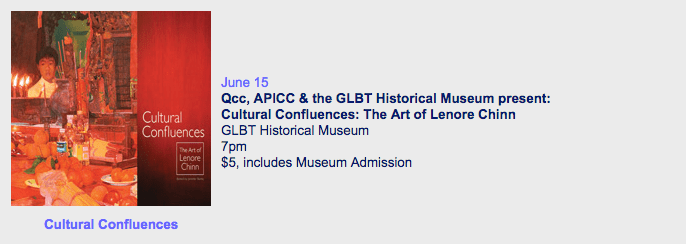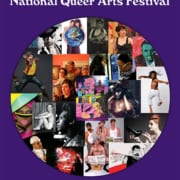Cultural Confluences
Lenore Chinn’s inclusion in Harmony Hammond’s “Lesbian Art in America: A Contemporary History,” the first study of American lesbian visual artists, vastly expanded her national visibility. Chinn’s portraits document the historical evolution of San Francisco’s queer community.
In February 2011 API Cultural Center published, Cultural Confluences: The Art of Lenore Chinn with essays by scholars Tirza True Latimer, Moira Roth and Valerie Soe. These essays articulate a sensibility informed by civil rights and social justice issues and Chinn’s experience of traditional Chinese culture along with the myriad world-views she encountered in the bohemian 70’s.
This evening’s program is a celebration of community and features Chinn in critical discussion with scholars and essayists Tirza True Latimer, Chair of Visual and Critical Studies at California College of the Arts, Moira Roth, Trefethen Chair of Art History, Mills College and Valerie Soe, a writer, experimental videomaker and Assistant Professor of Asian American Studies at San Francisco State University.
Biography
Lenore Chinn began painting when she was growing up in San Francisco’s Richmond district, focusing on portraiture to explore the super-realistic depiction of a wide spectrum of people of color, lesbians and same sex couples. Chinn’s inclusion in Harmony Hammond’s “Lesbian Art in America: A Contemporary History,” the first study of American lesbian visual artists, vastly expanded her national visibility.
Her portraits documenting the historical evolution of San Francisco’s queer community challenge the social conventions that currently constitute the racialized order of things.
The artist was a founding member of Lesbians in the Visual Arts and Queer Cultural Center and is affiliated with the Asian American Women Artists Association. She is included in “Encyclopedia of Asian American Artists” published by Greenwood Press in 2007. In February, 2011 API Cultural Center published, Cultural Confluences : The Art of Lenore Chinn.
Scholars and essayists, Tirza True Latimer, Moira Roth and Valerie Soe, map the chronology of Chinn’s life and times. These essays articulate a sensibility informed by civil rights and social justice issues and Chinn’s experience of traditional Chinese culture along with the myriad world-views she encountered in the bohemian 70’s.


